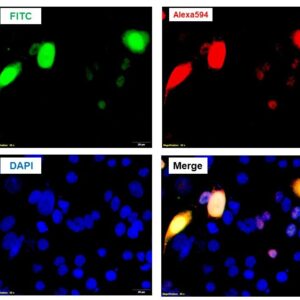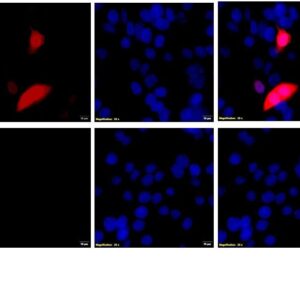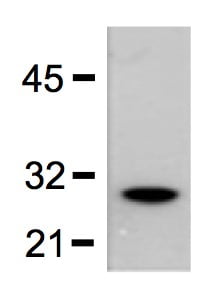| Weight | 1 lbs |
|---|---|
| Dimensions | 9 × 5 × 2 in |
| host | mouse |
| isotype | IgG2b |
| clonality | monoclonal |
| concentration | 1 mg/mL |
| applications | ELISA, ICC/IF, WB |
| reactivity | tagged fusion proteins |
| available sizes | 1 mg, 100 µg, 25 µg |
mouse anti-GFP monoclonal antibody (GF28R) 7414
Price range: $100.00 through $2,600.00
Antibody summary
- Mouse monoclonal to GFP
- Suitable for: WB,ICC/IF,ELISA
- Reacts with: tagged fusion proteins
- Isotype: IgG2b
- 100 µg, 25 µg, 1 mg
mouse anti-GFP monoclonal antibody (GF28R) 7414
| antibody |
|---|
| Database link: P42212 |
| Tested applications WB,ICC/IF,ELISA |
| Recommended dilutions WB: 1:1000-3000 ICC/IF: 1:500-2000 For best results with other assays (e.g.: Dot, ELISA, IP, etc), please determine optimal working dilution by titration test. |
| Immunogen GFP from the jellyfish?Aequorea victoria?N-terminal peptide-KLH conjugates. |
| Size and concentration 25, 100, 1000µg and 1 mg/mL |
| Form liquid |
| Storage Instructions -20°C for 2 years or more. °Centrifuge after first thaw to maximize product recovery. Aliquot to avoid repeated freeze-thaw cycles. Store aliquots at 4°C for several days to weeks. |
| Storage buffer PBS, pH 7.2, 0.05% NaN3 |
| Purity affinity purified |
| Clonality monoclonal |
| Isotype IgG2b |
| Compatible secondaries goat anti-mouse IgG, H&L chain specific, peroxidase conjugated polyclonal antibody 5486 goat anti-mouse IgG, H&L chain specific, biotin conjugated, Conjugate polyclonal antibody 2685 goat anti-mouse IgG, H&L chain specific, FITC conjugated polyclonal antibody 7854 goat anti-mouse IgG, H&L chain specific, peroxidase conjugated polyclonal antibody, crossabsorbed 1706 goat anti-mouse IgG, H&L chain specific, biotin conjugated polyclonal antibody, crossabsorbed 1716 goat anti-mouse IgG, H&L chain specific, FITC conjugated polyclonal antibody, crossabsorbed 1721 |
| Isotype control Mouse monocolonal IgG2b - Isotype Control |
| target relevance |
|---|
| Protein expression of GFP and GFP tagged proteins can be checked and quantified using this antibody in Western blotting. When imaging in situ, GFP fluorescence can be amplified by this antibody when used in conjunction with a suitable fluorescent label or secondary antibody. Click for more on: epitope tags and GFP |
| Protein names Green fluorescent protein |
| Gene names GFP,GFP |
| Protein family GFP family |
| Mass 26886Da |
| Function FUNCTION: Energy-transfer acceptor. Its role is to transduce the blue chemiluminescence of the protein aequorin into green fluorescent light by energy transfer. Fluoresces in vivo upon receiving energy from the Ca(2+)-activated photoprotein aequorin. |
| Tissues TISSUE SPECIFICITY: Photocytes. |
| Structure SUBUNIT: Monomer. {ECO:0000269|PubMed:9782051}. |
| Post-translational modification PTM: Contains a chromophore consisting of modified amino acid residues. The chromophore is formed by autocatalytic backbone condensation between Ser-65 and Gly-67, and oxidation of Tyr-66 to didehydrotyrosine. Maturation of the chromophore requires nothing other than molecular oxygen. {ECO:0000269|PubMed:8448132}. |
| Biotechnology BIOTECHNOLOGY: Green fluorescent protein has been engineered to produce a vast number of variously colored mutants, fusion proteins, and biosensors. Green fluorescent protein can be mutated to emit at different wavelengths such as blue for BFP (when Tyr-66 is replaced by His), cyan for CFP (when Tyr-66 is replaced by Trp), and yellow for YFP (when Thr-203 is replaced by Tyr). Further generation of mutants led to more stable proteins (at 37 degrees Celsius for example) with brighter fluorescence and longer fluorescence lifetimes. Fluorescent proteins and their mutated allelic forms have become a useful and ubiquitous tool for making chimeric proteins, where they function as a fluorescent protein tag. Typically they tolerate N- and C-terminal fusion to a broad variety of proteins. They have been expressed in most known cell types and are used as a noninvasive fluorescent marker in living cells and organisms. They enable a wide range of applications where they have functioned as a cell lineage tracer, reporter of gene expression, or as a measure of protein-protein interactions (PubMed:17685514, PubMed:17685554, PubMed:8578587, PubMed:8707053, PubMed:9145105, PubMed:9154981, PubMed:9759496, PubMed:9782051). Can also be used as a molecular thermometer, allowing accurate temperature measurements in fluids. The measurement process relies on the detection of the blinking of GFP using fluorescence correlation spectroscopy (PubMed:17685514). {ECO:0000269|PubMed:17685514, ECO:0000269|PubMed:17685554, ECO:0000269|PubMed:8578587, ECO:0000269|PubMed:8707053, ECO:0000269|PubMed:9145105, ECO:0000269|PubMed:9154981, ECO:0000269|PubMed:9759496, ECO:0000269|PubMed:9782051}. |
| Target Relevance information above includes information from UniProt accession: P42212 |
| The UniProt Consortium |
Data
 |
| 1:1,000 (1µg/mL) Ab dilution probed against HEK293 cells transfected with GFP-tagged protein vector: untransfected control (1), 1µg (2) and 10µg (3) of cell lysates used. |
Publications
| pmid | title | authors | citation |
|---|---|---|---|
| 36353537 | Parthenolide and arsenic trioxide co-trigger autophagy-accompanied apoptosis in hepatocellular carcinoma cells. | Juan Yi, Xia Gong, Xiao-Yang Yin, Li Wang, Jin-Xia Hou, Jing Chen, Bei Xie, Gang Chen, Li-Na Wang, Xiao-Yuan Wang, Da-Chun Wang, Hu-Lai Wei | Front Oncol 12:988528 |
| 36052744 | Herbivore-induced Ca(2+) signals trigger a jasmonate burst by activating ERF16-mediated expression in tomato. | Chaoyi Hu, Shaofang Wu, Jiajia Li, Han Dong, Changan Zhu, Ting Sun, Zhangjian Hu, Christine H Foyer, Jingquan Yu | New Phytol 236:1796-1808 |
| 35880301 | ECM dimensionality tunes actin tension to modulate endoplasmic reticulum function and spheroid phenotypes of mammary epithelial cells. | FuiBoon Kai, Guanqing Ou, Richard W Tourdot, Connor Stashko, Guido Gaietta, Mark F Swift, Niels Volkmann, Alexandra F Long, Yulong Han, Hector H Huang, Jason J Northey, Andrew M Leidal, Virgile Viasnoff, David M Bryant, Wei Guo, Arun P Wiita, Ming Guo, Sophie Dumont, Dorit Hanein, Ravi Radhakrishnan, Valerie M Weaver | EMBO J 41:e109205 |
| 35880301 | ECM dimensionality tunes actin tension to modulate endoplasmic reticulum function and spheroid phenotypes of mammary epithelial cells. | FuiBoon Kai, Guanqing Ou, Richard W Tourdot, Connor Stashko, Guido Gaietta, Mark F Swift, Niels Volkmann, Alexandra F Long, Yulong Han, Hector H Huang, Jason J Northey, Andrew M Leidal, Virgile Viasnoff, David M Bryant, Wei Guo, Arun P Wiita, Ming Guo, Sophie Dumont, Dorit Hanein, Ravi Radhakrishnan, Valerie M Weaver | EMBO J 41:e109205 |
| 35851616 | ADAR1 downregulation by autophagy drives senescence independently of RNA editing by enhancing p16(INK4a) levels. | Xue Hao, Yusuke Shiromoto, Masayuki Sakurai, Martina Towers, Qiang Zhang, Shuai Wu, Aaron Havas, Lu Wang, Shelley Berger, Peter D Adams, Bin Tian, Kazuko Nishikura, Andrew V Kossenkov, Pingyu Liu, Rugang Zhang | Nat Cell Biol 24:1202-1210 |
Protocols
| relevant to this product |
|---|
| Western blot ICC |
Documents
| # | SDS | Certificate | |
|---|---|---|---|
| Please enter your product and batch number here to retrieve product datasheet, SDS, and QC information. | |||
Only logged in customers who have purchased this product may leave a review.















Reviews
There are no reviews yet.